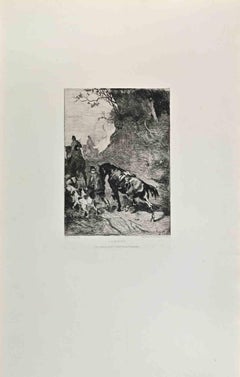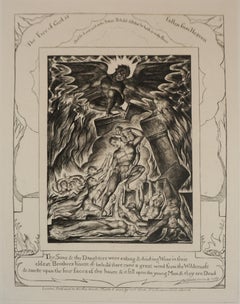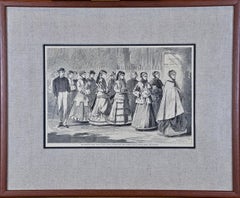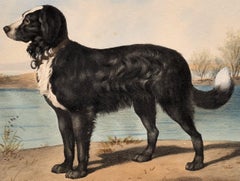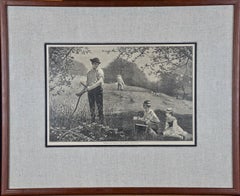1870s Landscape Prints
to
4
47
81
8
Overall Width
to
Overall Height
to
89
20
7
5
3
3
2
1,011
2,153
9,969
4,011
116
115
710
511
594
1,139
1,461
1,650
1,316
627
658
86
50
80
41
19
19
17
16
15
11
10
10
9
7
6
6
5
5
4
4
4
3
108
17
14
11
8
16
90
96
37
Period: 1870s
La Montée - Etching by Christian Johannes Nieuwenhuys - 1870s
Located in Roma, IT
La Montée is an artwork realized by Christian Johannes Nieuwenhuys in the 1870s.
Etching.
Good conditions.
Realized for the "Société des Aquafortistes. Born on the initiative of...
Category
Modern 1870s Landscape Prints
Materials
Etching
The Angelus - Original etching - Ed. Durand Ruel, 1873
Located in Paris, IDF
Jean Francois MILLET (after)
The Angelus, 1873
Original Etching
Engraved by Martinez under the supervision of PUVIS DE CHAVANNES
Printed signature in the ...
Category
Impressionist 1870s Landscape Prints
Materials
Etching
Illustrations From The Book of Job - "The Fire of God is Fallen From Heaven"
Located in Soquel, CA
"Illustrations of the Book of Job" Engraving "The Fire of God is Fallen From Heaven...And the Lord said unto Satan Behold All that he hath is in thy Power"
Engraving, third printing...
Category
Symbolist 1870s Landscape Prints
Materials
Handmade Paper, Engraving
$3,720 Sale Price
20% Off
Winslow Homer 19th Century Woodcut Engraving "The Morning Walk"
Located in Alamo, CA
This Winslow Homer woodcut engraving entitled "The Morning Walk, Young Ladies' School Promenading the Avenue", was published in Harper's Weekly in the...
Category
American Impressionist 1870s Landscape Prints
Materials
Engraving, Woodcut
Antique Dog Lithograph Taste of Alfred De Dreux, France ca. 1870 Newfoundland
By Alfred de Dreux
Located in SANTA FE, NM
Antique Dog Portrait
Lithograph in the Taste of Alfred De Dreux
Newfoundland
France, circa 1870
Lithography
25 5/8 x 19 5/8 (28 x 20 frame) inches
Six lithographs of dog portraits...
Category
Romantic 1870s Landscape Prints
Materials
Lithograph
Winslow Homer 19th Century Woodcut Engraving "Making Hay"
Located in Alamo, CA
This Winslow Homer woodcut engraving entitled "Making Hay", was published in Harper's Weekly in the July 6, 1872 edition. It depicts a two men hand cutting high grass on a hill. The man in the foreground is looking at a young boy and a girl (presumably his children), who are sitting on the ground with a picnic basket.
This beautiful Homer woodcut engraving is presented in a brown wood frame and a light beige fabric mat with a black inner mat. The print is in excellent condition.
There are two other Homer woodcut engravings in identical frames and mats that are listed on 1stdibs. See LU117326148332 and LU117326148272. These would make a wonderful display grouping. A discount is available for the purchase of two or all three of these prints.
This Winslow Homer engraving...
Category
American Impressionist 1870s Landscape Prints
Materials
Engraving, Woodcut
The Traghetto
Located in New York, NY
James Whistler (1834-1903), The Traghetto, etching and drypoint, 1879-80, signed with the butterfly on the tab and inscribed “imp”. Reference: Kennedy 19...
Category
Impressionist 1870s Landscape Prints
Materials
Drypoint, Etching
Windmills in Holland - Original etching - Ed. Durand Ruel, 1873
By Claude Monet
Located in Paris, IDF
Claude MONET (after)
Windmills in Holland, 1873
Original Etching
Engraved by Gaucherel under the supervision of Monet
Printed signature in the plate (with misspelled signature Monnet)
On laid paper 20,5 x 30 cm (c. 8 x 12 in)
INFORMATION : This etchings was edited in 1873 by Galerie Durand Ruel...
Category
Impressionist 1870s Landscape Prints
Materials
Etching
Paysage d'Italie - Etching by Camille Corot - 1870s
Located in Roma, IT
Paysage d'Italie is an artwork realized by Corot in the 1870s.
Etching.
Good conditions.
Realized for the "Société des Aquafortistes. Born on the initiative of the publisher Alfre...
Category
Modern 1870s Landscape Prints
Materials
Etching
The Bridge, Santa Maria
Located in New York, NY
James Whistler (1834-1903), The Bridge, Santa Marta, 1879-80, etching with drypoint, printed in sepia on fine laid paper. Signed with the butterfly and inscribed imp on the tab (also with an exceedingly light butterfly lower right in the plate). Kennedy 204, probably eighth (final) state; Glasgow 201, probably state 9 (of 9) (cf. Margaret F. MacDonald, Grischka Petri, Meg Hausberg, and Joanna Meacock, James McNeill Whistler: The Etchings, a catalogue raisonné, University of Glasgow, 2011), Lochnan 199. Trimmed to the platemark by the artist, h: 11.8 x w: 7.9 in / h: 30 x w: 20.1 cm.
A fine impression, printed with subtle tone.
The bridge theme occurs repeatedly in Whistler’s vistas. It is also the main focus of more than one of the Venetian prints. While some bridges are seen from below, from where one would see it if approaching in a gondola (for example Ponte del Piovan, Kennedy 209), The Bridge depicts the scene from a high perspective, opening up the view into the far distance. The small boat approaching the arch in the foreground is again, as in the earlier Thames prints, a stock motif that is probably ultimately derived from the Japanese woodcuts of Hokusai and Hiroshige. The bridge here is the Ponte de le Terese over the Rio de l’Arzere in the Santa Marta quarter.
The early biography of Whistler by Elizabeth and Joseph Pennell is essential for its “immense quantity of information” but also notorious for “the inherent hyperbole and misinformation” (Eric Denker, Annotated Bibliography, in Fine, p. 184). Still, it is worth quoting from the Pennels’ appraisal of The Bridge: “Simplicity of expression has never been carried further. Probably the finest plate, in its simplicity and directness, is The Bridge. Whistler now obtained the quality of richness by suggesting detail, and also by printing. In The Traghetto...
Category
Impressionist 1870s Landscape Prints
Materials
Drypoint, Etching
La Répétition - Etching by Edouard Moyse - 1870s
Located in Roma, IT
La Répétition is an artwork realized by Edouard Moyse in the 1870s.
Etching.
Image size:19x29
Good conditions.
Realized for the "Société des Aquafortistes. Born on the initiati...
Category
Modern 1870s Landscape Prints
Materials
Etching
Limehouse
Located in New York, NY
JAMES MCNEILL WHISTLER (1834-1903)
Limehouse, from Notes
lithotint, on cream Japan paper mounted to plate paper (as issued), 1878, Spink, Stratis & Tedesch 7, second state (of three)...
Category
Impressionist 1870s Landscape Prints
Materials
Lithograph
Louisiana: A Framed 19th Century Map by O.W. Gray
Located in Alamo, CA
This framed 19th century map of the Louisiana territory was published in "Gray's Atlas of the United States with General Maps of the World, accompanied by Descriptions Geographical, Historical, Scientific and Statistica" published in 1873 in Philadelphia by O.W. Gray and Son and Stedman, Brown and Lyon. It is a highly detailed map of Louisiana...
Category
1870s Landscape Prints
Materials
Engraving
19th century engraving landscape bridge industrial river scene ink signed
Located in Milwaukee, WI
"Fulham A.K.A. Chelsea" is an original etching by James Abbott MacNeill Whistler. The artist signed the piece in the plate with his butterfly monogram in the lower right. IT was publ...
Category
Impressionist 1870s Landscape Prints
Materials
Etching
Un Debarquement en Angleterre (A Disembarking in England)
Located in Fairlawn, OH
Un Debarquement en Angleterre
(A Disembarking in England)
etching, drypoint, aquatint, roulette and spirit ground, 1879
Signed with the artist’s red owl stamp, Lugt 977 (see photo)
...
Category
Impressionist 1870s Landscape Prints
Materials
Drypoint
L’Hiver a Paris ou La Neige a Paris
Located in New York, NY
Felix Buhot (1847-1898), L’Hiver a Paris ou La Neige a Paris, 1879, etching, aquatint, drypoint, roulette. [signed and dated in the plate Felix Buhot Par...
Category
Realist 1870s Landscape Prints
Materials
Drypoint, Etching, Aquatint
Veduta del Castello dell'Acqua Felice... Etching by Giovan B. Piranesi - 1875
Located in Roma, IT
Etching realized by Giovan Battista Piranesi in 1875.
Image dimension: 40.5x52 cm.
Sheet dimension 68.5x74.3 cm.
Signed on the plate lower right. Plate from Views of Rome. Excell...
Category
Modern 1870s Landscape Prints
Materials
Etching
Good Times on the Old Plantation
Located in Missouri, MO
Currier & Ives (Publishers)
"Good times on the Old Plantation" 1872
Handcolored Lithograph
Size Height 10 in.; Width 13.9 in.
Framed Size: approx 16 x 19.5
Category
Victorian 1870s Landscape Prints
Materials
Lithograph
Spring - Etching by Robert Walker Macbeth - 1879
Located in Roma, IT
A finely detailed etching realized after William Fowler, showing a tranquil pastoral scene under blossoming spring trees, where cows rest or graze and a woman tends to calves.
The s...
Category
Modern 1870s Landscape Prints
Materials
Etching
Les Marché aux Chevaux de Paris... - Etching by Jules Jacques Veyrassat - 1853
Located in Roma, IT
Etching realized by Jules Jacques Veyrassat (1828-1893) after Rosa Bonheur (1822-1899).
It depicts the bustling Paris horse market, showing vigorous movement as horses are led and s...
Category
Modern 1870s Landscape Prints
Materials
Etching
Antique Dog Lithograph Taste of Alfred De Dreux, France ca. 1870 Bulldog & Frog
By Alfred de Dreux
Located in SANTA FE, NM
Antique Dog Portrait
Lithograph in the Taste of Alfred De Dreux
Bulldog and Frog
France, circa 1870
Lithography
25 5/8 x 19 5/8 (28 x 20 frame) inches
Six lithographs of dog portr...
Category
Romantic 1870s Landscape Prints
Materials
Lithograph
La Mare au Drac (Champagne) - Etching by Félix-Hilaire Buhot - 1875
Located in Roma, IT
Etching on laid paper
Signed in plate lower left: F. Buhot
Published by Cadart & Luquet, Éditeurs, 79 Rue Richelieu, Paris
With the blindstamp of the Société des Aquafortistes, lower...
Category
Modern 1870s Landscape Prints
Materials
Etching
Les Demoiselles de Village - Etching by Gustave Courbet - 1870s
Located in Roma, IT
Les Demoiselles de Village is an artwork realized by Gustave Courbet in the 1870s.
Etching.
Good conditions.
Realized for the "Société des Aquafortistes. Born on the initiative o...
Category
Modern 1870s Landscape Prints
Materials
Etching
Le Vieux Pont de Vernon (Eure) - Etching by Alfred Taiée - 1875 ca.
Located in Roma, IT
Etching on laid paper
Signed in plate lower right: A. Taiée
Published by Cadart & Luquet, Éditeurs, 79 Rue Richelieu, Paris
With the blindstamp of the Société des Aquafortistes, ...
Category
Modern 1870s Landscape Prints
Materials
Etching
Sortie du Port de Honfleur - Etching by Johan B. Jongkind - 1864
Located in Roma, IT
Etching on laid paper
Signed and dated in plate lower left: Jongkind 1864
Published by Cadart & Luquet, Éditeurs, 79 Rue Richelieu, Paris
With the blindstamp of the Société des Aquaf...
Category
Modern 1870s Landscape Prints
Materials
Etching
Éléphants d’Afrique (Souvenir du Luxembourg)-Lithograph by Auguste Raffet - 1879
Located in Roma, IT
Etching in laid paper.
A highly detailed etching by Léon Gambard, depicting a majestic herd of African elephants gathered at a watering hole under a vast, expansive sky. The animals...
Category
Modern 1870s Landscape Prints
Materials
Lithograph
"The Great Fire of Boston" Currier & Ives, Urban landscape late 19th century
Located in New York, NY
Currier & Ives
The Great Fire of Boston , 1872
Hand-colored lithograph
7 5/16 x 12 11/16 inches
After undertaking apprenticeships in Boston and Philadelphia, Currier set up a print...
Category
Realist 1870s Landscape Prints
Materials
Lithograph
Antique Dog Lithograph, Taste of Alfred De Dreux, France circa 1870 Greyhounds D
By Alfred de Dreux
Located in SANTA FE, NM
Antique Dog Portrait
Lithograph in the Taste of Alfred De Dreux
Greyhounds D
France, circa 1870
Lithography
25 5/8 x 19 5/8 (28 x 20 frame) inc...
Category
Romantic 1870s Landscape Prints
Materials
Lithograph
Souvenir d’Eza
Located in Roma, IT
Cliché-verre.
Magnificent proof of ancient edition, numbered in red pencil on verso, and whose subject wasn’t included in the later reprints by Bouasse-Lebel and Le Garrec. Signed on...
Category
Modern 1870s Landscape Prints
Materials
Plate Glass
Novembre
Located in Roma, IT
Signed the plate with the artist's monogram “TS”lower left. Inscription “C. Lovera imp” lower right. Very rare print from “L'Art in Italia”, 1871.Original Prints.
Image Dimensions : ...
Category
Realist 1870s Landscape Prints
Materials
Etching
Antique Dog Lithograph Taste of Alfred De Dreux, France ca. 1870 Saint Bernard A
By Alfred de Dreux
Located in SANTA FE, NM
Antique Dog Portrait
Lithograph in the Taste of Alfred De Dreux
Saint Bernard
France, circa 1870
Lithography
25 5/8 x 19 5/8 (28 x 20 frame) inches
Six lithographs of dog portrait...
Category
Romantic 1870s Landscape Prints
Materials
Lithograph
La Nouvelle Orléans - Original Woodcut Print After T.A. Weber - 1876
By Theodore Alexander Weber
Located in Roma, IT
La Nouvelle Orléans is a wonderful black and white xilograph on paper, realized in 1876 by an unknown artist, whose signature is not completely readable on lower right corner, after the German artist and marine painter Theodore Alexander Weber (1838-1907).
With high meticulousness of sign this original print describes the new port...
Category
Modern 1870s Landscape Prints
Materials
Woodcut
Vue du Port au Chemin de Fer à Honfleur - Etching by Johan B. Jongkind - 1870s
Located in Roma, IT
Vue du Port au Chemin de Fer à Honfleur is an artwork realized by Jongkind in the 1870s.
Etching.
Good conditions.
Realized for the "Société des Aquafortistes. Born on the initi...
Category
Modern 1870s Landscape Prints
Materials
Etching
Bords du Sornin - Etching by Armand Charnay - 1860s
Located in Roma, IT
Bords du Sornin is an artwork realized by A.Charnay in the 1870s.
Etching.
Image size:19x29
Good conditions.
Realized for the "Société des Aquafortistes. Born on the initiative...
Category
Modern 1870s Landscape Prints
Materials
Etching
"Un Grain à Trouville" (Squall at Trouville) from L'Illustration Nouvelle
Located in Soquel, CA
"Un Grain à Trouville" (Squall at Trouville) from L'Illustration Nouvelle
Dramatic etching of an approaching storm by Félix Hilaire Buhot (French,...
Category
Barbizon School 1870s Landscape Prints
Materials
Laid Paper, Etching, Aquatint
After the Bath - Original etching - Ed. Durand Ruel, 1873
Located in Paris, IDF
Jean Baptiste Camille COROT (after)
After the Bath, 1873
Original Etching
Engraved by Boilevin under the supervision of COROT
Printed sig...
Category
Impressionist 1870s Landscape Prints
Materials
Etching
Landscape - Original Etching - 1879
Located in Roma, IT
"Landscape" is an original drawing in etching, realized by Edwin Edwards.
The state of preservation of the artwork is very good.
Sheet dimension: 18.5 ...
Category
Modern 1870s Landscape Prints
Materials
Etching
"Skating on Ladies' Pond Central Park": Winslow Homer 19th C. Woodcut Engraving
Located in Alamo, CA
This Winslow Homer woodcut engraving entitled "Skating on the Ladies' Skating-Pond in Central Park, New York", was published in Harper's Weekly in the January 28, 1860 edition. It depicts a large number of men, women and children skating on a recently opened pond in Central Park. At the time of publication of this engraving, Central Park was in the early stages of construction. This engraving documents the very early appearance of Frederick Law Olmstead and Calvert Vaux's masterpiece of landscape design. According to Olmsted, the park was "of great importance as the first real Park made in this century – a democratic development of the highest significance". The people of New York were very proud of the plans for their park. It was stated at the time: "Our Park, which is progressing very satisfactorily under the management of the Commissioners, will undoubtedly be, one of these days, one of the finest place of the kind in the world...Those who saw the Park before the engineers went to work on it are amazed at the beautiful sites which have been contrived with such unpromising materials; all fair persons believe that the enterprise is managed with honesty and good taste."
Skating was rapidly rising in national popularity in part due to the opening of Central Park’s lake to skaters on a Sunday in December 1858 with 300 participants. The following Sunday it attracted ten thousand skaters. By Christmas Day, a reported 50,000 people came to the park, most of them to skate. There were rules governing who could use the skating pond. “The Ladies’ Pond...
Category
American Impressionist 1870s Landscape Prints
Materials
Engraving, Woodcut
Old Battersea Bridge View, Chelsea, 1879 - Etching on Paper
Located in Soquel, CA
Old Battersea Bridge View, Chelsea, 1879 - Etching on Paper
Black and white 1897 etching titled "Old Battersea Bridge View" by Charles John Watson (British, 1846-1947). View at Chelsea from the bank of the Thames, with boats moored in foreground at left, Old Battersea Bridge in background, and Chelsea Old Church beyond.
Signed and dated "Charles J Watson...
Category
Impressionist 1870s Landscape Prints
Materials
Paper, Ink, Etching
$360 Sale Price
20% Off
Ministère de la Marine - Etching by Charles Meryon - 1870s
Located in Roma, IT
Ministere de la Marine is an artwork realized by Charles Meryon in the 1870s.
Etching.
Image size: 17x14
Good conditions.
Realized for the "Société des Aquafortistes. Born on th...
Category
Modern 1870s Landscape Prints
Materials
Etching
Souvenir du Jura - Etching - 1870s
Located in Roma, IT
Souvenir du Jura is an artwork realized by X.Dananche in the 1870s.
Etching.
Good conditions.
Realized for the "Société des Aquafortistes. Born on the initiative of the publisher ...
Category
Modern 1870s Landscape Prints
Materials
Etching
Antique Dog Lithograph, Taste of Alfred De Dreux, France circa 1870 Wolfhound E
By Alfred de Dreux
Located in SANTA FE, NM
Antique Dog Portrait
Lithograph in the Taste of Alfred De Dreux
Wolfhound E
France, circa 1870
Lithography
25 5/8 x 19 5/8 (28 x 20 frame) inches
Six lithographs of dog portraits....
Category
Romantic 1870s Landscape Prints
Materials
Lithograph
Un Sentier - Etching by Tancrède Abraham - 1870s
Located in Roma, IT
Un Sentier is an artwork realized by Tancrède Abraham in the 1870s.
Etching.
Image size:34x23
Good conditions.
Realized for the "Société des Aquafortistes. Born on the initiati...
Category
Modern 1870s Landscape Prints
Materials
Etching
Carrefour des Gorges d'Apremont - Etching by Théophile Chauvel - 1870s
Located in Roma, IT
Carrefour des Gorges d'Apremont is an artwork realized by T. Chauvel in the 1870s.
Etching.
Good conditions.
Realized for the "Société des Aquafortistes. Born on the initiative ...
Category
Modern 1870s Landscape Prints
Materials
Etching
Environs de Bergame - Etching by Giberto Borromeo - 1870s
Located in Roma, IT
Environs de Bergame is an artwork realized by Giberto Borromeo in the 1870s.
Etching.
Image size:12x15 and 14. x 22.
Good conditions.
Realized for the "Société des Aquafortiste...
Category
Modern 1870s Landscape Prints
Materials
Etching
En Italie - Etching by Giberto Borroméo - 1870s
Located in Roma, IT
En Italie is an artwork realized by Giberto Borroméo in the 1870s.
Etching.
Good conditions.
Realized for the "Société des Aquafortistes. Born on the initiative of the publisher...
Category
Modern 1870s Landscape Prints
Materials
Etching
Le Matin - Etching by Eugène Delâtre - 1870s
Located in Roma, IT
Le Matin is an artwork realized by E. Delatre in the 1870s.
Etching.
Image size:16x25
Good conditions.
Realized for the "Société des Aquafortistes. Born on the initiative of th...
Category
Modern 1870s Landscape Prints
Materials
Etching
Umewaka Shrine in the Rain
By Kobayashi Kiyochika
Located in Burbank, CA
Umewaka Shrine, from an untitled series of prints depicting Tokyo. A woman braces her umbrella against the rain and a man waits out the storm next to his jinriksha in this view of th...
Category
Edo 1870s Landscape Prints
Materials
Handmade Paper, Mulberry Paper, Woodcut
Ancien Boulevard Extérieur de Paris - Etching by Adolphe Martial-Potémon - 1870s
Located in Roma, IT
Ancien Boulevard Extérieur de Paris is an artwork realized by Adolphe Martial-Potémon in the 1870s.
Etching.
Image size:20x28.
Good conditions.
Realized for the "Société des Aq...
Category
Modern 1870s Landscape Prints
Materials
Etching
William Ridley - Etching by William Ridley - 1870s
Located in Roma, IT
Draham Harbour is an artwork realized by William Ridley in the 1870s.
Etching.
Good conditions.
Realized for the "Société des Aquafortistes. Born on the initiative of the publish...
Category
Modern 1870s Landscape Prints
Materials
Etching
Rue du Rivage - Etching by Armand Queyroy - 1870s
Located in Roma, IT
Rue du Rivage is an artwork realized by A.Queyroy in the 1870s.
Etching.
Image size: 26x21
Good conditions.
Realized for the "Société des Aquafortistes. Born on the initiative ...
Category
Modern 1870s Landscape Prints
Materials
Etching
Harfleur - Etching by Alfred-Louis Brunet-Debaines - 1870s
Located in Roma, IT
Harfleur is an artwork realized by A. Brunet Debaines in the 1870s.
Etching.
Good conditions.
Realized for the "Société des Aquafortistes. Born on the initiative of the publishe...
Category
Modern 1870s Landscape Prints
Materials
Etching
Rose Trémière - Etching by Alfred Taiée - 1870s
Located in Roma, IT
Rose Trémière is an artwork realized by Alfred Taiée in the 1870s.
Etching.
Good conditions.
Realized for the "Société des Aquafortistes. Born on the initiative of the publisher...
Category
Modern 1870s Landscape Prints
Materials
Etching
Foret De Fontainebleau - Etching by Pontus Cinier - 1870s
Located in Roma, IT
Foret De Fontainebleau is an artwork realized by Pontus Cinier in the 1870s.
Etching.
Good conditions.
Realized for the "Société des Aquafortistes. Born on the initiative of the p...
Category
Modern 1870s Landscape Prints
Materials
Etching
Chateau du Clos lucé à Amboise - Etching by Armand Queyroy - 1870s
Located in Roma, IT
Chateau du Clos lucé à Amboise is an artwork realized by A. Queyroy in the 1870s.
Etching.
Good conditions.
Realized for the "Société des Aquafortistes. Born on the initiative o...
Category
Modern 1870s Landscape Prints
Materials
Etching
Rue Du Canal à Figeac - Etching by Étienne Mazas - 1870s
Located in Roma, IT
Rue Du Canal à Figeac is an artwork realized by E.Mazas in the 1870s.
Etching.
Good conditions.
Realized for the "Société des Aquafortistes. Born on the initiative of the publis...
Category
Modern 1870s Landscape Prints
Materials
Etching
Rade De New-York - Etching by Anatole De Bonsonge - 1870s
Located in Roma, IT
Rade De New-York is an artwork realized by Anatole De Bonsonge in the 1870s.
Etching.
Good conditions.
Realized for the "Société des Aquafortistes. Born on the initiative of the p...
Category
Modern 1870s Landscape Prints
Materials
Etching
Au Fil de l'Eau - Etching by Aufray - 1870s
Located in Roma, IT
Au Fil de l'Eau is an artwork realized by Aufray in the 1870s.
Etching.
Good conditions.
Realized for the "Société des Aquafortistes. Born on the initiative of the publisher Alf...
Category
Modern 1870s Landscape Prints
Materials
Etching
A Nohant-Vico - Etching by Joseph François Villevieille - 1870s
Located in Roma, IT
A Nohant-Vico is an artwork realized by Joseph François Villevieille in the 1870s.
Etching.
Good conditions.
Realized for the "Société des Aquafortistes. Born on the initiative of...
Category
Modern 1870s Landscape Prints
Materials
Etching
La Chasse aux Canards - Etching by Charles Émile Jacque - 1870s
Located in Roma, IT
La Chasse aux Canards is a black and white etching realized by Charles Émile Jacque (French, 1813–1894) in 1870s.
Titled in the lower.
Image size: 30.5cmx16cm.
Very Good condition...
Category
Modern 1870s Landscape Prints
Materials
Etching
